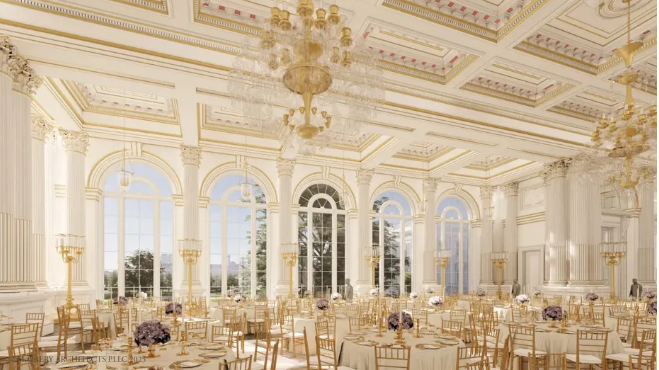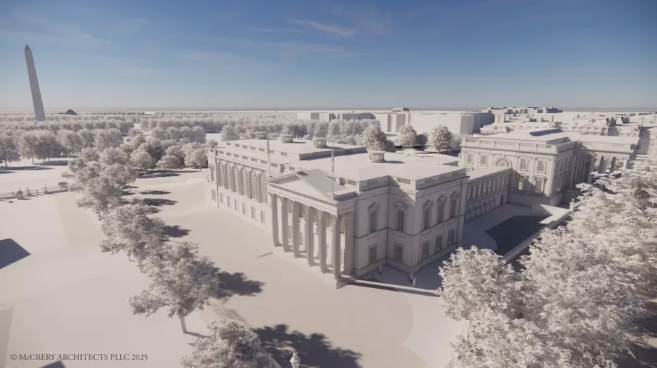
President Trump's Controversial Ballroom
There has been complete “performance” outrage from the left after President Trump announced modifications to the East Wing of the White House to create a new ballroom for major events and to host visiting dignitaries.
They act as if this is something new and totally ignore the many additions and changes to the White House made during previous administrations.


Key Facts About Trump’s New White House Ballroom
1. Size and Structure
- The ballroom is reportedly about 24,000 square feet, roughly equivalent to half a football field — significantly larger than the East Room (which is only 5,600 sq. ft.).
- The ceiling height is around 40 feet, designed to allow for chandeliers modeled after those in Mar-a-Lago and the Versailles Hall of Mirrors.
- Structurally, it’s a subterranean expansion connected to the East Wing through a new corridor, built largely below ground to minimize visual disruption to the historical White House appearance — a design solution negotiated with the National Park Service.
2. Seating and Capacity
- Banquet capacity: about 1,200 guests (comparable to the grandest hotel ballrooms in D.C.).
- Theater seating capacity: around 2,500, suitable for large diplomatic dinners, state functions, or political events.
- The room can be partitioned into sections via modular acoustic walls, enabling simultaneous media events or smaller private functions.
A few thoughts from conservative media:
- American Thinker: Anger over the White House ballroom is purely performative – The irony is that the people shrieking most loudly belong to the same class of people who tried to burn the White House and tore down Founders’ statues. – So, here’s a little background. The East Wing of the White House was nothing fancy. – It was hastily built in 1942, when D.C. was inundated with people working on WWII-related matters…
- American Thinker: Even The Washington Post Concedes That Trump’s Ballroom Is A Good Idea – Reality keeps catching up with the Democrats. – It turns out that lots of presidents have altered the White House to keep up with the times, and that these complaints are coming from the same people who feverishly attacked the White House and other American monuments in 2020.
- One America News: Representative Eric Swalwell demands that 2028 Democrat presidential candidates pledge to destroy Trump’s ballroom – He added in a comment that he would find it acceptable if the next Democrat president were to “rename it the Barack Obama Ballroom,” though the White House has not suggested any name for the space…
Here are numerous facts about modifications to the White House made by previous administrations.
Structural Overhauls
🏛️ Theodore Roosevelt (1902):
- Undertook a massive renovation, removing Victorian-era ornamentation to restore the neoclassical appearance.
- Moved the presidential offices from the main building to a new West Wing—this is when the modern concept of the “White House Office” began.
- Installed the first electric elevator and remodeled the interior to suit a more modern presidency.
🏗️ William Howard Taft (1909):
- Expanded Roosevelt’s West Wing and added the Oval Office—the design was meant to symbolize continuity and authority, inspired by Washington’s bow-shaped rooms.
🔥 Harry S. Truman (1948–1952):
- Conducted the Truman Reconstruction, one of the most significant renovations in White House history.
- The interior was completely gutted and rebuilt with a steel frame after structural engineers discovered the building was near collapse.
- Hidden story: some of the old timber was infested and warped; the chandeliers were literally swaying when people walked upstairs.
- Added a balcony on the South Portico (the “Truman Balcony”), which caused quite a controversy at the time for altering the mansion’s historic façade.
Utility and Technological Updates
📡 Franklin D. Roosevelt (1933–1945):
- Installed elevators, ramps, and handrails for accessibility (he suffered from polio).
- Expanded and strengthened communications—like radio wiring, naval phone lines, and early secure communication systems.
📞 John F. Kennedy (1961–1963):
- Updated the Situation Room in response to the Cuban Missile Crisis.
- Jacqueline Kennedy undertook a complete interior restoration, establishing the White House Historical Association to maintain historical integrity. Much of the antique furniture and period detail we see today comes from her project.
📺 Richard Nixon (1969–1974):
- Installed a bowling alley and expanded secure communications (especially after Watergate began).
- Set up the first “tap recording” system—technically a “modification” with long-term consequences.
🌐 Bill Clinton (1990s):
- Oversaw major IT and networking infrastructure upgrades—the White House entered the internet era.
- Hillary Clinton refurbished and modernized the East Wing and residential areas.
Security and Grounds Enhancements
🏰 Franklin D. Roosevelt & Dwight Eisenhower:
- Expanded subterranean bunkers (precursors to today’s PEOC – Presidential Emergency Operations Center).
- Early Cold War modifications under Eisenhower included improved blast protection and tunnels.
🏗️ Barack Obama (2009–2017):
- Oversaw major but discreet underground infrastructure work, including a massive modernization of utilities (HVAC, fiber-optic networks, electrical systems).
- Added solar panels on the roof (the second president to do so; Carter did it first in 1979, Reagan removed them, Bush reinstalled a few, Obama replaced with modern ones).
- Introduced subtle perimeter fortifications—bollards, restored fences, and advanced surveillance upgrades after multiple security breaches.
- Added a state-of-the-art media briefing room renovation in 2007 (technically under Bush but heavily used and refined during Obama’s era).
Other Noteworthy Personal Touches
- Carter: Solar panels + modest living ethos—he often walked rather than rode within the grounds.
- Reagan: Installed modern alarms and Secret Service communication systems.
- George W. Bush: Renovated the Situation Room again post-9/11, with advanced secure video and data links.
The Hidden Subterranean World of the White House
Let’s separate this into three categories:
- Confirmed Facilities (officially acknowledged)
- Strongly Supported Evidence & Credible Testimony
- Persistent Rumors & Speculative Structures
- Confirmed Facilities
🏗️ The White House Basement & Sub-Basements
- Origin: Constructed originally around 1790s–1820s, expanded significantly after WWII.
- Houses mechanical rooms, food storage, communications infrastructure, and security offices.
- Most of the “visible” parts are logistical: air filtration systems, water, electricity, and IT networks.
🛡️ The PEOC (Presidential Emergency Operations Center)
- Created during Franklin D. Roosevelt’s era amid early WWII fears of German bombings.
- Served as a bomb shelter beneath the East Wing; expanded during the Cold War.
- Truman Reconstruction (1948–1952) allowed for deeper reinforcement and newer access shafts.
- The PEOC was famously used by Dick Cheney and others during 9/11.
- Confirmed features: hardened blast doors, communication hubs, independent oxygen supply, decontamination chamber, and elevators descending multiple levels.
📞 The Situation Room Complex
- Technically above ground, but interfaces with subterranean communications systems.
- Upgraded post-9/11 by George W. Bush and again under Obama for secure data links.
- Connected by tunnels to other White House sections for rapid access.
- Strongly Supported Evidence & Credible Testimony
🚇 Secret Tunnels (White House to Treasury, and beyond)
- The White House–Treasury Tunnel is confirmed: a secure underground passageway originally built for FDR’s security and as an evacuation route.
- Another tunnel likely connects to the Old Executive Office Building (EEOB), situated west of the main mansion.
- Multiple maintenance engineers and Secret Service veterans (some speaking off-record) have referenced secondary routes under Lafayette Park and potentially reaching Blair House (the president’s guest residence).
🔐 Deepening & Expansion (Cold War Onward)
- During the Eisenhower and Kennedy administrations, subterranean expansion was prioritized due to nuclear threat scenarios.
- Evidence suggests multi-level compartments were added beneath the PEOC—not open to general staff or even most senior aides.
- Documentation in Defense Department archives (particularly from Civil Defense planning in the 1950s) hints at shared architectural plans with known “continuity of government” (COG) facilities like Mount Weather and Raven Rock (Site R).
🏞️ Emergency Egress Routes
- Several declassified Secret Service planning documents (1970s–1990s) refer to “south perimeter egresses”—implying exits somewhere beneath the South Lawn, possibly leading toward the Ellipse area or Potomac River approaches for helicopter or motorcade extraction.
- Persistent Rumors & Speculative Structures
These lack direct proof but have compelling circumstantial hints:
🔦 “Level 5” or “Sub Level D”
- Rumored to be a multi-story command and survival bunker below the known PEOC.
- Some contractors involved in the 2010–2013 “Construction Hole” project (an enormous, fenced, and secretive excavation on the White House South Lawn) reported extensive underground work. Officially described as a “utility upgrade,” the scale was far beyond typical infrastructure replacements.
- Many believe it secretly connected to deeper facilities capable of housing the president and essential staff for extended crises.
🚀 “Continuity of Government” Link
- A common theory is that tunnels connect D.C.’s federal core (White House, Capitol, Pentagon) to exterior “COG” nodes such as Mount Weather (VA), Site R / Raven Rock (PA/MD border), and possibly Camp David.
- Technologically feasible via pressurized or maglev systems, though not publicly verified.
- Strategic reasoning: D.C. is vulnerable. If communication satellites were jammed or bomb shelters breached, escape corridors would ensure command survival.
🕵️ “West Wing Chamber”
- Multiple presidents have referenced feeling “earthquake-like rumbling” during unexplained underground construction phases (notably under Obama in 2011).
- Washington Post reporters noted the duration and depth of the south excavation were inconsistent with stated purposes.
📡 “CIC – Command Integration Center” Hypothesis
- Some intelligence observers suspect there’s a direct portal or network hub linking NSA, DoD, and WH communications below the property.
- The presence of high-capacity fiber optic conduits installed in the early 2010s supports such an assertion—it would unify surveillance, defense, and executive control in a single secure network.
What’s Fact vs. Fiction?
Category | Status | Purpose / Function |
Basic basements & PEOC | ✅ Confirmed | Emergency relocation, communications |
Tunnel to Treasury | ✅ Confirmed | Secure presidential movement |
Tunnel to EEOB / Blair House | 🟧 Highly likely | Continuity of command routes |
Multi-level bunker complex | 🟨 Strong circumstantial evidence | Long-term survival infrastructure |
D.C.-to-COG remote link | 🟥 Highly speculative | Strategic evacuation & control network |